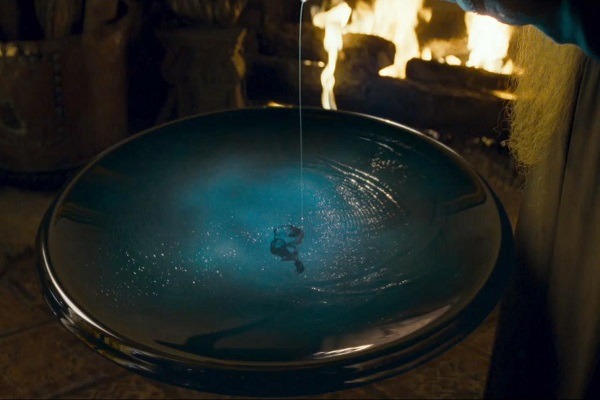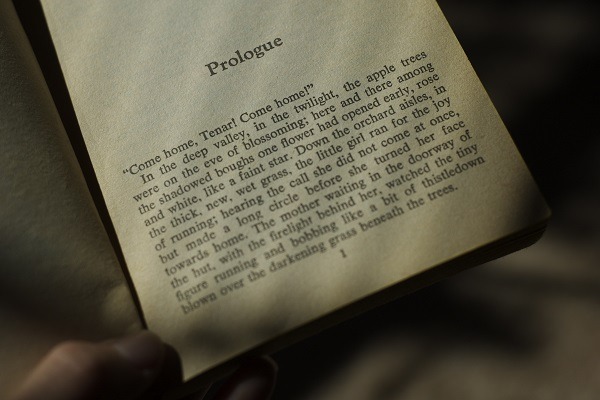It may not be something you’ve considered extensively while writing or planning a story, but backstory is a crucial part of any novel.
Backstory can simply be defined as:
A narrative providing a history or background context, especially for a character or situation in a literary work.”
Whatever the story you’re telling, and however you’ve decided to tell it, it’s inevitable that backstory will come into play through both narrative and character development.
While backstory is something found in every genre, it’s an especially important element in speculative fiction novels. There are a couple of reasons for this.
Firstly, as in any other genre, it’s an essential part of character development. Backstory rounds out characters, providing insight into the sort of person they are by exploring their past and their journey so far. It’s one of the most effective ways to make your characters more memorable.
However, it also lends a sense of realism and depth to your characters, which is vital in a fantasy or science fiction story. Readers aren’t necessarily going to be able to relate to the fantastical setting or plot, so creating well-rounded, realistic characters they can relate to and believe in is absolutely essential.
Secondly, backstory is an important part of the process of world-building. Whether you’ve created an entirely new world, or reimagined our world in the light of new technology or events, you should treat your setting almost as if it’s a character itself.
You need to introduce your world to readers and help them understand how it works and why it is the way it is. To do this, you’ll need to give it some history – a setting’s equivalent to backstory.
Now, if you’re feeling a little overwhelmed at the thought of creating all this backstory, don’t worry! We’ve put together some essential tips to help you learn how to write backstory, how to incorporate it effectively into your novel, and how to know when to leave it out.

Flesh out backstory before writing
Before you launch into writing your story, you’ll need to have most of its key elements clear in your head: characters, setting and a rough outline of the plot (or at least the major events).
This isn’t always as easy as it sounds, especially with speculative fiction! Complicated plots, entirely invented settings and large casts of characters can be hard for a writer to keep track of – and if the writer can’t follow the story, the reader definitely can’t.
So, to get organised, you’ll want to start planning your novel.
The scale and style of planning you’ll do will depend on how you work as a writer. As George R. R. Martin once said, some writers are architects, planning everything down to the letter; some are gardeners, planting a seed and letting things grow from there.
No matter which type of writer you are, you’ll need to think carefully about backstory when you’re planning (or at least planting the seed for) your novel.
Characters
Start off by creating a master list of all the essential characters within your story. (This list will undoubtedly grow and change as you write, so initially, just add the characters you’re certain you want to include.) Divide this character list into two columns labelled ‘Significant Backstory’ and ‘Insignificant Backstory’.
Those characters who fall under ‘Insignificant Backstory’ should be minor players with little to no bearing on the plot and arc of the narrative. You can create backstory for them to immerse yourself more fully in the story, but don’t spend too much time on the characters under this heading.
Concentrate instead on those under ‘Significant Backstory’. These are your main players: those whose existence and actions will play an important role in the story as a whole.
While creating these characters, you’ll need to consider not just who they are and how they relate directly to the main plot, but also why they’ve come to be the person they are. In speculative fiction especially, characters’ pasts tend to play an important role in the story that’s being told.
You know what we mean: the downtrodden peasant must rise above his circumstances to protect what’s important to him; the sheltered princess must learn the ways of the real world to save her people; the arrogant scientist must learn from his mistakes to preserve the future of the race.
You’ll need to decide how aspects of your main characters’ histories relate to the journey they’re completing in your novel.
A character’s background, and the significant events in their past, will have an effect on things like:
- Their personality
- Their motivations, goals and values
- Their outlook on the world
- The way they think, speak, act and react to different situations.
For each of your main characters, write a basic timeline of events in their life, and note why these events are significant. What emotional effect have they had on the character? How have they shaped the above aspects of who the character is as a person?
These are important questions to answer as you flesh out your ideas into living, breathing characters.

Setting
After considering your characters, write down everything you know so far about your setting. (Our ultimate guide to world-building offers extensive hints and tips to get you started.)
Here’s where backstory comes in: you need to give your world some history. It can be as richly detailed or as simple as you like, but you must ensure your novel doesn’t propose a world that seems to have sprung up out of nowhere, fully formed.
Past events – both natural and human – will have shaped the form of your world, just as past events in characters’ lives will have shaped the person they are and will become.
Give substance to these past events so that your world starts to feel like a real place for your characters to inhabit. Have fun with this part and be as inventive as you like, but remember to keep things realistic in the context of your world – that is, ensure the world abides by its own rules, without any leaps of logic or deus ex machina.

Decide what to include and what to leave out
Although backstory is critically important to the author, who must know his or her characters thoroughly, the reader only needs sparing, critical details – enough to ensure the character’s motivation is clear.” – Susan Forest
After you’ve considered the backstories of your characters and your world, it’s time to decide how much your readers need to know – and to prepare yourself to relinquish what they don’t.
It can be tempting to jam in as much detail as possible, especially if you’ve spent plenty of time preparing your backstories, but remember: you need to write for your audience. You need to keep them engaged and intrigued, not lose them in a backlog of details and particulars.
Be brutal and honest with yourself here. If ever there’s a time for ‘killing your darlings’, it’s when you’re deciding how much backstory to tell!
The history of your world, for example, probably won’t receive much direct airtime (so to speak). You won’t be straight-up telling readers the details of your universe; instead, you’ll be implying those details through description and character observations.
Your characters’ backstories can be a little more thoroughly and directly explored, as long as those backstories play a role in the story – and as long as they’re effectively and subtly included.
Which brings us to our next piece of advice…

Weave backstory subtly through narrative
The art of subtlety can be hard to master, especially when it comes to writing backstory in speculative fiction. Just like the overzealous, extraneous details we discussed above, a blunt or inelegant method of delivering backstory can drive readers away.
The most common of these ineffective methods is called info-dumping. This is where the writer straight-out explains all the information relating to the current action, whether it’s a recount of past events or too-specific details about the setting.
Needless to say, info-dumping is not a good thing. It disrupts momentum and can produce some pretty uninteresting prose, both of which can jolt readers out of the flow of the story. After all, it’s a story they’ve come to read, not a character study or a history lesson!
There’s also such a thing as revealing too much too soon. You want to keep your readers guessing throughout your novel, creating a sense of anticipation, excitement and intrigue. It’s hard to do this if you spoon-feed them every detail!
The key is to draw readers into the main story – the here and now – and make them care about the characters and the outcome of the plot. Entice them to want to know more about the people, the world and the plotline, and hold off giving them that information until you absolutely must.
When you do finally provide those juicy bits of backstory, you’ll want to make sure you’re avoiding the dreaded info-dump and incorporating them in the most effective way possible. Let’s go over some key methods that can help you do this.

Choose the best way of incorporating backstory
There are many different ways of incorporating backstory into your novel, and each method has its advantages, drawbacks and conditions. Take a look below at a few common ways to deliver backstory, then consider which of these will be of most use to you and the story you’re telling.
Characters’ thoughts and memories
This is perhaps the most simple method of incorporating your characters’ backstories into the narrative. The majority of novels are written through first-person or close third-person perspective, both of which allow the writer to explore a character’s thought processes, internal monologues and memory recollections.
Once you’ve gotten your readers inside a character’s head, you can use their thoughts and memories to subtly explore parts of their history, and even the history of their world.
There’s one condition to this method: you need to make it realistic by only including backstory-related thoughts and memories when they can be naturally triggered by something.
Your protagonist, for example, probably wouldn’t have a sudden recollection of the night her house burned down while she’s peacefully picking flowers in a meadow. She would, however, have such a jolt in memory if she was to notice a column of smoke billowing in the distance, or the charred trunk of a tree ravaged by wildfire.
You have two choices when exploring characters’ memories. You can take a fragmented approach, alluding to details just clearly enough that your reader understands the significance of the memory; or, if the memory is complete and the details are vivid enough, it can be written in a form of a flashback.

Flashbacks
A flashback is slightly different in that the backstory it explores is not just a memory: it’s a living, breathing scene from the past that becomes part of the novel itself, not just part of a character’s thoughts.
While they’re a useful tool for inserting backstory into your novel, flashbacks should be used with caution and discretion. Like the prologue technique we’ll discuss below, flashbacks are often met with mixed reactions from readers.
By definition, a flashback requires you to take a reader out of the present and deposit them into the past for a time. Use this technique too often and you’ll disrupt the forward flow of the plot; write a slow-moving or irrelevant flashback and you’ll frustrate your readers, who care more about what happens next than what’s already happened.
The key to an engaging, effective flashback is that it offers something to either pique or satisfy the curiosity of your readers. Like characters’ thoughts and memories, a flashback must also be convincingly triggered by something in the story.
Flashbacks must do any or all of the following:
- Reveal key information relevant to the plot
- Develop a character significantly
- Elicit an emotional reaction towards a character
- Add a new and exciting dimension to the story.

Dialogue
Dialogue can be used for both character- and setting-related backstories in speculative fiction. By having characters discuss certain historical or personal events, you’ll be able to deliver backstory without heaping it on your readers in narrative format.
In addition, this method allows you to reveal more about characters’ personalities and thought processes through the way they’re speaking and acting.
Does the recall of certain events send them into a quiet rage, all clenched fists and gritted teeth? Do they smile involuntarily (or a little sadly) while talking about a certain person from their past? Are they reluctant to talk about something in particular? And for all of the above – why?
These are all backstory-related questions you can answer through a conversational exchange between characters.
There are a few caveats to using dialogue as a vehicle for backstory, however. It’s not as easy as using characters as mouthpieces for information you think readers should know.
The first thing you should remember is that writing authentic dialogue is key. You need to ensure that it’s realistic to have characters speak of and explain certain things. For example: you and your friend, both of whom have lived in the same city your entire lives, wouldn’t start spouting its history to each other apropos of nothing, would you?
Of course not – and neither would your characters. You can’t teach backstory to your readers via characters discussing things they’d normally take for granted. You can, however, have characters talk about things that are new to both readers and themselves; as they talk things through in an attempt to understand them, your readers will feel like they’re part of the discussion as well.
Part of character’s quest/journey
A journey or quest is a defining element of speculative fiction stories, with countless novels revolving around physical and/or metaphorical journeys undertaken by their characters.
While the aim of most character quests is to complete a concrete task, other quests are a pursuit of knowledge. It’s this type of quest that allows writers to utilise backstory as an integral plot device.
For example, your character might be seeking vital information about their mysterious parentage; this gives structure and purpose to your plot, while also allowing your readers to learn backstory right alongside the character.
That’s not to say that task-based quests can’t involve backstory – quite the opposite. As we mentioned before, these journeys are often metaphorical as well as literal, meaning that characters grow and learn more about themselves and their world along the way.
To this end, instead of incorporating backstory as the aim of the quest itself, you can simply use the other backstory methods we’ve discussed to help your characters discover and remember things along the journey.

Magical/scientific means
Obviously, this method is specific to fantasy and science fiction novels, and doesn’t apply to straight literary fiction (unless you’re writing magic realism or something similar!).
It’s perfectly acceptable to utilise the magical or scientific elements of your world to deliver necessary backstory in an engaging way. But, like all other methods of incorporating backstory, this one also comes with a caveat. The supernatural or sci-fi elements you use must add some more depth to your story, or at least feel like a natural, uncontrived inclusion.
‘Visions of the past’ are a common way to explore elements of backstory in fantasy novels. In Erika Johansen’s Queen of the Tearling trilogy, for example, the protagonist experiences trance-like states in which she is able to see past events from another person’s perspective. This adds a whole different layer to the history of Johansen’s world and to the story as a whole.
In a similar vein, the Pensieve in the Harry Potter series is a device that allows Harry to view other people’s memories, giving him (and readers) important insight into the history of his enemy, Voldemort. Harry’s journeys into the Pensieve are a key plot point and a significant part of his and several other characters’ development.
Your imagination is the limit when it comes to exploring backstory through magical or scientific means. But however you choose to do so, ensure it’s in keeping with the rest of your created world, and that it feels like a part of the story – not just a convenient plot device.

Prologue
Despite being a fairly common literary device, the prologue can elicit mixed reactions from readers.
On one hand, it’s a time-honoured tradition of speculative fiction – epic fantasy in particular – and it can warm your readers up nicely for the fantastical tome they’re about to read.
On the other hand, a prologue can have the negative effect of drawing a reader into a story, only to abruptly pull them out and throw them headfirst into another! It can also appear stuffy, old-fashioned or unnecessary if it isn’t executed effectively.
So what constitutes an effective prologue? And more importantly, is your prologue an effective means of providing backstory to readers?
To answer this, you need to ask yourself a few questions about what you’re thinking of including in the prologue:
- Does it reveal vital plot information that the reader must know straight away?
- If you leave it out, is there something important missing from the story?
- If you turn it into ‘Chapter One’ instead, or include it at a later point in the novel, does it impede narrative flow?
If the answer to all three questions is ‘yes’, then your prologue is probably necessary. If any of your answers were ‘no’, you may want to reconsider its inclusion.

Final tips
As we’ve seen above, there’s definitely a lot to think about when considering backstory for your novel! To round things off, we’ve put together a few final tips and things to keep in mind as you go on your way.
Remember: the better you know your characters, the better you can write them
Writing well-rounded, authentic characters as well as an engaging plot is a challenge, to put it very mildly. But the better you get to know your characters through their backstories, the more convincingly you’ll be able to write them, and the better your story will be.
If you become an expert on your characters, you’ll come to know exactly how their mind works and how they’ll react in any given situation. This will make it much easier to write your story and bring your characters to life.
Edit wisely
When you’ve finally finished writing and you’re ready to start revising your novel, go through and identify everything that can be considered backstory. Then ask yourself whether each piece of information needs to be there, or whether the story remains the same if it’s removed.
If it is necessary backstory, ensure it’s been worked naturally into the narrative and that it doesn’t feel forced.
Keep unused backstories filed away
Many speculative fiction writers are in the series business, and even if you don’t think you are now, later you might want to revisit your world and your story. If and when you do, having extensive backstory details on hand will get you back into the zone and will most likely come in handy for future stories.
You may even end up writing a companion-style history book for your world, like George R. R. Martin did!
Enjoy the process!
Always remember to let yourself enjoy the writing process – especially aspects like writing backstory. Indulge a little, because those elements will often end up being for your eyes only. Immerse yourself in the creation of your world and your characters and have fun doing what you love best!
One response to “The Complete Guide To Creating Backstory In Speculative Fiction”
Thank you for such a detailed explanation!
I’m devouring every technical-writing bit of information I can while I convince myself to put my drawings into words.